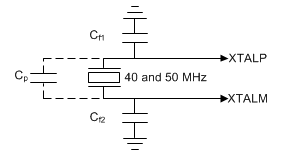SWRS211C May 2017 – October 2018 IWR1443
PRODUCTION DATA.
- 1Device Overview
- 2Revision History
- 3Device Comparison
- 4Terminal Configuration and Functions
-
5Specifications
- 5.1 Absolute Maximum Ratings
- 5.2 ESD Ratings
- 5.3 Power-On Hours (POH)
- 5.4 Recommended Operating Conditions
- 5.5 Power Supply Specifications
- 5.6 Power Consumption Summary
- 5.7 RF Specification
- 5.8 Thermal Resistance Characteristics for FCBGA Package [ABL0161]
- 5.9
Timing and Switching Characteristics
- 5.9.1 Power Supply Sequencing and Reset Timing
- 5.9.2 Synchronized Frame Triggering
- 5.9.3 Input Clocks and Oscillators
- 5.9.4 Multibuffered / Standard Serial Peripheral Interface (MibSPI)
- 5.9.5 LVDS Interface Configuration
- 5.9.6 General-Purpose Input/Output
- 5.9.7 Controller Area Network Interface (DCAN)
- 5.9.8 Serial Communication Interface (SCI)
- 5.9.9 Inter-Integrated Circuit Interface (I2C)
- 5.9.10 Quad Serial Peripheral Interface (QSPI)
- 5.9.11 JTAG Interface
- 5.9.12 Camera Serial Interface (CSI)
- 6Detailed Description
- 7Applications, Implementation, and Layout
- 8Device and Documentation Support
- 9Mechanical, Packaging, and Orderable Information
Package Options
Mechanical Data (Package|Pins)
- ABL|161
Thermal pad, mechanical data (Package|Pins)
Orderable Information
5.9.3.1 Clock Specifications
An external crystal is connected to the device pins. Figure 5-4 shows the crystal implementation.
 Figure 5-4 Crystal Implementation
Figure 5-4 Crystal Implementation NOTE
The load capacitors, Cf1 and Cf2 in Figure 5-4, should be chosen such that Equation 1 is satisfied. CL in the equation is the load specified by the crystal manufacturer. All discrete components used to implement the oscillator circuit should be placed as close as possible to the associated oscillator CLKP and CLKM pins.Note that Cf1 and Cf2 include the parasitic capacitances due to PCB routing.

Table 5-6 lists the electrical characteristics of the clock crystal.
Table 5-6 Crystal Electrical Characteristics (Oscillator Mode)
| NAME | DESCRIPTION | MIN | TYP | MAX | UNIT |
|---|---|---|---|---|---|
| fP | Parallel resonance crystal frequency | 40 | MHz | ||
| CL | Crystal load capacitance | 5 | 8 | 12 | pF |
| ESR | Crystal ESR | 50 | Ω | ||
| Temperature range | Expected temperature range of operation | –40 | 105 | ºC | |
| Frequency tolerance | Crystal frequency tolerance(1)(2)(3) | –50 | 50 | ppm | |
| Drive level | 50 | 200 | µW | ||
In the case where an external clock is used as the clock resource, the signal is fed to the CLKP pin only; CLKM is grounded. The phase noise requirement is very important when a 40-MHz clock is fed externally. Table 5-7 lists the electrical characteristics of the external clock signal.